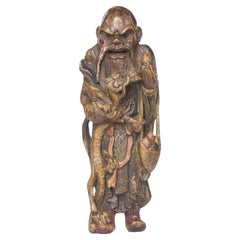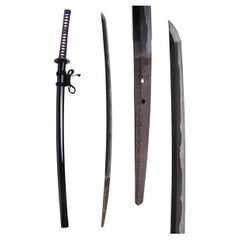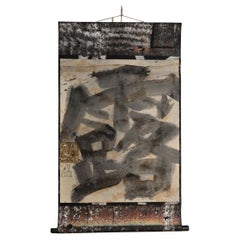Giuseppe Piva Japanese Art
to
19
13
8
8
4
2
2
2
1
1
1
1
1
1
1
1
Saishiki netsuke of Ryujin
Located in Milano, IT
Saishiki netsuke of Ryujin
Style of Yoshimura Shuzan, 18th century
Signed: Shuzan
Height: 9,8 cm
Provenance:
W. L. Behrens collection, no. 311
Literature:
H. L. Joly, W. L. Behren...
Category
20th Century Antiquities
Materials
Wood
Toppai kabuto, Signed Haruta Yoshimasa and dated 1802
Located in Milano, IT
Toppai kabuto,
Samurai helmet from the Kajiwara clan.
Edo period, dated 1802.
Signatures:
筑藩士官 梶原 景泰 命春田 昌芳造之 享和二年壬 秋也
Chikushū (?) Shikan (officer) Kajiwara Kageyasu (?) Mikoto (lo...
Category
Antique Early 19th Century Japanese Arms, Armor and Weapons
Materials
Iron
Inro by Mochizuki Hanzan (1743-90?) Edo Period, 18th century
Located in Milano, IT
Mochizuki Hanzan (1743-90?)
Edo Period, 18th century
Decorated with inlaid colored ceramic with a stag and maple leaves
Height: 8.4 cm
Sealed Hanzan
Mochizuki Hanzan (1743-90?...
Category
Antique 18th Century Japanese Lacquer
Materials
Wood
A Hizen Katana in koshirae
Located in Milano, IT
A Hizen Katana in koshirae
Signed 肥前國河内大掾藤原正廣
Hizen kuni kawachi daijō Fujiwara Masahiro
-
Early Edo Period (1615-1867)
-
NBTHK Hozon Tōken
-
Nagasa [leng...
Category
Antique 17th Century Japanese Arms, Armor and Weapons
Materials
Steel
Suda Kokuta (1906-1990) 露, Tsuyu (dew)
Located in Milano, IT
Suda Kokuta (1906-1990)
露, Tsuyu (dew)
Kakejiku: ink and slight colour on paper
Signed with seal Suda Kokuta and dated in black pencil “1989”
104cm x 61cm
The single Chinese...
Category
Late 20th Century Paintings and Screens
Materials
Paper
Suji-bachi kabuto and menpo Signed by Myōchin Muneaki and dated 1853
Located in Milano, IT
Suji-bachi kabuto and menpo
Signed by Myōchin Muneaki and dated 1853
Signature: Kaei 6 - Ushidoshi Oshu Nihonmatsu-ju Myōchin Ki (no) Muneaki saku
Made in 1853 by Myōchin Ki Muneak...
Category
Antique 18th Century and Earlier Metalwork
Materials
Iron
Hon-kozane ni-mai do tosei gusoku
Located in Milano, IT
Hon-kozane ni-mai do tosei gusoku
Samurai armor in revival style
Edo Period, 17th to 18th century
Signature on kabuto: Jōshū jū Saotome Ietada
Kabuto [helmet]: A russet iron (tetsu sabiji) sixty-two plate kabuto, each mounted with twenty-five small tapered standing rivets (ko-boshi) of decreasing size; the front plate, larger than the others, is fitted with two lines of rivets, while the rear one is left empty, for a total of 1.550 rivets.
The typical "Saotome-byo", an extra rivet which is almost an additional signature of the Saotome armorers, is visible inside.
Maedate [helmet crest]: Kuwagata (stylized horns) with shakudo kuwagata-dai (support) fitted with three hanabishi (flower-shaped family crest) and a large gilt-wood peony
Menpō [mask]: A russet iron (tetsu sabiji) ressei-men (mask with fierce expression)
Dō [cuirass]: Ni-mai dō (made in two parts) with hon-kozane (true scale) construction. Stencilled leather plates with engraved shakudo borders, fine pierced kanamono (application) bearing a hanabishi.
Sode [shoulder guards]: Large type (ō-sode), with fine kanamono and decorations.
Kote [sleeves]: In russet iron, with a hanabishi on the back of the hand (tekko).
Haidate [thigh guard]: Of hakama type (full trousers), made of tied rectangular iron plates.
Suneate [shin guards]: Finished in black urushi lacquer.
Accessories: A saihai (commander’s baton); high-level kara-bitsu (storage box)
With its large sode (shoulder guards) and old-fashioned construction, the style of the armor is reminiscent of the medieval suits...
Category
Antique Late 17th Century Japanese Arms, Armor and Weapons
Materials
Iron
Sujibachi kabuto 62-plate samurai helmet Haruta school, Edo period
Located in Milano, IT
Sujibachi kabuto
62-plate samurai helmet
Haruta school, Edo period
17th-18th century
A lamellar helmet consisting of sixty-two plates joined with five rows of rivets. The surface is...
Category
Antique Mid-17th Century Japanese Metalwork
Materials
Iron
Dangae do tosei gusoku A blue-laced samurai armor with cuirass of double style
Located in Milano, IT
Dangae do tosei gusoku
A blue-laced samurai armor with cuirass of double style
Edo Period, 18th century
Kabuto [helmet]: Black lacquered eboshi-nari kabuto, in the form of this ...
Category
Antique 18th Century Arms, Armor and Weapons
Materials
Iron
Kogo in the Shape of a Deer
Located in Milano, IT
Hiramaki-e lacquer, nashiji and fundame
Edo period, 19th century
Length: 10.5 cm, height: 6.5 cm
Since the Heian period, The theme of deer and autumn plants has been ut...
Category
Antique 19th Century Japanese Lacquer
Materials
Wood
Tōkanmuri Kabuto Samurai Helmet in the Shape of a Court CAP
Located in Milano, IT
Tokanmuri kabuto
Samurai helmet in the shape of a court cap
Momoyama to early Edo Period
17th century
The wearing of helmets that reproduced the shapes of traditional ...
Category
Antique 17th Century Japanese Metalwork
Materials
Iron
Sogonari Kabuto Samurai Helmet Shaped as a Human Head Early Edo Period
Located in Milano, IT
Sogonari Kabuto
Samurai Helmet shaped as a Human Head
Early Edo Period (1615 - 1867).
Three-plates kawari kabuto covered with tawny hair to ...
Category
Antique Early 1700s Metalwork
Materials
Fur
Okitenugui Kabuto Samurai Helmet Shaped as a Head Towel Saika, Early Edo Period
Located in Milano, IT
Okitenugui kabuto
Samurai helmet shaped as a head towel
Saika, early Edo period, 17th century
The Haruta armorers who moved to Kii province in the early 17th century, took the name from the village where they worked, Saika, near Wakayama, possibly on request of the local daimyo, Asano Yukinaga, a great armour amateur. Specialised in the construction of plate helmets, they produced mainly two typologies of kabuto: one with six plates covered with a chrysanthemum-shaped plate on top and one shaped as a “head towel”, called okitenugui. The latter type of kabuto employs very heavy plates crafted in a curved manner and was improved in order to make it resistant to firearms.
This okitenugui kabuto features some distinctive decorations of the Haruta school, including the application of cut-out iron elements, including eyebrows, washers and lozenge-shaped decorations on the sides. The ring on the top, however, is a rare feature and could be used to hold a small war flag.
Category
Antique 17th Century Metalwork
Materials
Iron
Large Wood Netsuke of a Shishi
Located in Milano, IT
Large wood netsuke of a shishi
Kyoto school, 18th/19th century
Height: 5.7cm
The large netsuke with a very nice patina, showing the mythical creatu...
Category
Antique 18th Century Japanese Sculptures and Carvings
Materials
Wood
Japanese Two-Panel Screen with Scenes at the Pleasure Quarters, 18th Century
Located in Milano, IT
In the pleasure districts, the stringent codes were meant to be forgotten. In this painting, some clients are watching from outside the teahouse, while some are entering, one of them...
Category
Antique 18th Century Japanese Paintings and Screens
Materials
Paper
Ceramic Tea Bowl 'Chawan', by Kamisaka Sekka
Located in Milano, IT
A ceramic tea bowl decorated with autumn grasses with signed and sealed tomobako.
Painter and designer, Kamisaka Sekka (Japan, 1866-1942) has been one ...
Category
Antique 19th Century Japanese Ceramics
Materials
Ceramic
Jizai Okimono, Russet-Iron Articulated Figure of a Crab
Located in Milano, IT
Jizai Okimono
A russet-iron articulated figure of a crab
Edo Period (1615 - 1867), 19th Century
Length: 15 cm with extended limbs
The iron crab...
Category
Antique 19th Century Japanese Metalwork
Materials
Iron
Pair of Six-Panel Folding Screens with Peonies and Other Flowers
Located in Milano, IT
A pair of six-panel folding screens with peonies and other flowers
19th century
Each 72.5 by 241 cm
Small and elegant screens with an ideal scene depicting peonies and other flower species...
Category
Antique 19th Century Japanese Paintings and Screens
Materials
Paper
Japanese Lacquered Cabinet ‘Shodana’ from the Arashiyama Museum, 19th Century
Located in Milano, IT
The construction of this antique shodana is somehow different and richer than the traditional Japanese model: even if in fact there are the fundamental elements, which are a lower compartment closed by two sliding doors and three intermediate shelves, in this piece, there are many other closed parts, including two drawers. More, there are several lacquered parts decorated in superior-quality maki-e even in places that generally are left empty.
Panels are painted with gold lacquer with landscapes from the Genji monogatari; handles reproduce a sho, a rare antique musical instrument...
Category
Antique 19th Century Japanese Furniture
Materials
Wood
Samurai Mask with a Fierce Expression Ressei Menpo
Located in Milano, IT
Samurai mask with a fierce expression
Ressei Menpo
DATE Edo period (1615 - 1867), 18th century
A red lacquered high-level mask, with fierce (res...
Category
Antique 18th Century Japanese Metalwork
Materials
Iron
Koboshi Kabuto, Samurai Helmet with Standing Rivets Haruta School
Located in Milano, IT
Koboshi kabuto
Samurai helmet with standing rivets
Haruta School
Early Edo Period, 17th century
A 62-plate koboshi-bachi [helmet bowl with small s...
Category
Antique 17th Century Japanese Arms, Armor and Weapons
Materials
Iron
Shinto Sunnobi Tanto by Takahashi Naganobu, 1846
Located in Milano, IT
A Shinto Sunnobi Tanto
by Takahashi Naganobu, 1846
Unsho Takahashi Naganobu / A lucky day of August Koka san-nen (1846)
Yokota became monk with this sword
-
NBTHK Tokubetsu Hozon To...
Category
Antique 19th Century Japanese Metalwork
Materials
Iron
Go-Mai Uchidashi Dō Tosei Gusoku Samurai Armor Decorated with an Embossed Rabbit
Located in Milano, IT
Go-mai uchidashi do tosei gusoku
Samurai armor decorated with an embossed rabbit
Edo period, 19th century
This samurai armor is complete and original, with consistent elements...
Category
Antique 19th Century Japanese Metalwork
Materials
Iron
Pair of Japanese Two-Fold Screens with Flower Arrangements and Rare Birds
Located in Milano, IT
Karamono with flower arrangements and rare birds
Edo period, 18th century
Pair of two-panel folding screens Ink, colors, gofun and gold leaf on paper
Each 170 by 165 cm
...
Category
Antique 18th Century Japanese Paintings and Screens
Materials
Paper
Erotic Woodblocks Print ‘Shunga’, Kitagawa Utamaro
Located in Milano, IT
Negai no itoguchi (Unravelling the threads of desire), 1799
Oban yoko-e
Erotic prints have a primary role in the Japanese art history: sexual pleasure...
Category
Antique 18th Century Japanese Prints
Materials
Paper
Japanese Articulated Iron Jizai Okimono of a Lobster by Myochin Muneharu
Located in Milano, IT
This articulated okimono represents a naturalistically rendered lobster, with fully articulated limbs, antennae, body, and tail and comes with an inscribed wood storage box.
Signed:...
Category
Antique 19th Century Japanese Metalwork
Materials
Iron
Late 17th Early 18th Century Nabeshima Japanese Porcelain Plate Fruit Design
Located in Milano, IT
Dish with karatuuri (melon) design
Late 17th-early 18th century
Porcelain decorated with cobalt blu underglaze and red fruits
Diameter 15.2 cm
Nabeshima ware was made at Okawachi near Arita in Kyushu under the authority of the Nabeshima clan. The feudal lords of Nabeshima were so proud of their technological skill, that throughout the Edo period (1615-1867) they gave porcelain (and swords) as presents to the lords of other provinces.
Most of Nabeshima porcelain...
Category
Antique Late 17th Century Japanese Ceramics
Materials
Porcelain
Five-Case Inrō 19th Century Signed Kajikawa Saku Japanese Lacquer Box
Located in Milano, IT
Signed: “Kajikawa saku” and with a red pot seal
Height: 3 1/8in (7.9cm)
Provenance:
Michael Tomkinson Collection
Leonard Haber Collection
Literature:
Michael Tomkinson, A Japanese Collection, London: George Allen, 1898, no. 300
Each case with slightly recessed joints and with different grounds, including kinji, nashiji, togidashi maki-e and gyobu-nashiji, on the obverse decorated with a treasure ship laden with the attributes of the Seven Gods...
Category
Antique 19th Century Japanese Lacquer
Materials
Wood, Lacquer
Japanese Negoro Lacquer Tray 'Oshiki', 16th Century
Located in Milano, IT
Antique Negoro lacquer wares were produced at the Negoro-ji temple complex in Izumi Province. The red layers of lacquer on Negoro wares are intended to ...
Category
Antique 16th Century Japanese Lacquer
Materials
Wood
Japanese Lacquered Basin with Ear-Shaped Handles 'Mimidarai', 17th Century
Located in Milano, IT
Wooden basin with ear-shaped handles decorated with hiramaki-e lacquer and gold and silver kirigane on a nashi-ji ground.
The large and thick antique woo...
Category
Antique 17th Century Japanese Lacquer
Materials
Wood
Tomizo Saratani '1949', Natural Stone with Squid and Shrimps
Located in Milano, IT
Urushi lacquer on stone
Measures: 12.3 by 9.5 by 6.5 cm
Tomizo Saratani was born in Kyoto and has spent his life working on traditional japa...
Category
2010s Japanese Lacquer
Materials
Stone
Shibata Zeshin ‘1807-1891’, Barley
Located in Milano, IT
Medium: Hanging scroll; ink and pigments on silk
Signature: Zeshin
Seal: Tairyukyo
Date: circa 1880
Painting size: 98 x 20 cm
Mounts size: 182 x 32 cm
Shibata Zeshin...
Category
Antique Mid-19th Century Japanese Paintings and Screens
Materials
Paper
Shunichi Yabe Kofu #3, Wind of Light, Bizen Stoneware, 2013
Located in Milano, IT
What is immediately striking about the work of Yabe is his keen and natural sense of line. The artist, in fact, takes great care in first drawing an image of the work, and after hand-building the basic form a blend of Bizen mountain and rice-paddy clays, the work is carved with a knife into the form he had envisioned. After carving, the work is first bisque-fired and then its main-firing is executed in a small wood kiln for 3 days at a temperature reaching 1180 degrees. The resulting futuristic forms of Yabe’s stoneware present fresh new possibilities for Japanese Bizen clay in the 21st century.
Shunichi Yabe...
Category
21st Century and Contemporary Japanese Ceramics
Materials
Ceramic
Pair of Japanese Screens with Flowers of the Four Seasons, 19th Century
Located in Milano, IT
This pair of screens belongs to a genre of lyrical paintings of flowers, grasses, and other plants that flourished around the middle of the 17th century and became a specialty of the Sôtatsu studio. The use of a rather complex composition of clusters of flowers and the puddling of ink was initiated by Tawaraya Sôtatsu, the founder of the Rimpa School, who was active from 1600 until 1642. The screens are abstract and decorative but there is, at the same time, a keen sense of naturalism not only in the attention to accurate detail but in the profusion of vegetation. The passage of the year is symbolized by the variety of plants that bloom in different seasons. The tarashikomi - here used on leaves, petals and trunks - is a Classic Rinpa technique in which pale black ink or a color is brushed onto an area of a painting and then either darker ink, or the same or a contrasting color, is dropped into the first before it has completely dried, creating an effect of pooled colors with softly blurred edges. Its delicacy, preciousness, and effeminacy are identified with the over-refinement of its patrons, while the vigor, monochromatic discipline, sharp observation, and virile forms of the Kano school are a testament to the vitality of the rising warrior class. The plants are almost all identifiable: in the summer-spring part, you can find wheat, buttercups, irises, begonias, hydrangeas, coral bells...
Category
Antique 19th Century Japanese Paintings and Screens
Materials
Paper
Painting by Maeda Josaku (Japan, 1926 – 2007), Paysage Humain N° 14, 1960
Located in Milano, IT
Signed: Josaku Meda. 60.
Singed on the back: "Paysage humain" N°14 / 7.1960 / Josaku MAEDA / à Paris
Exhibitions:
Turin (Italy), Gissi Gallery, Collettiv...
Category
20th Century Japanese Paintings and Screens
Materials
Canvas
Japanese Folding Screen with a Spring Landscape, Kano School, 19th Century
Located in Milano, IT
The scene is dominated by a plum tree in bloom under which a couple of paradise birds is courting. The screen is crossed by a luxuriant creek, a typical feature of the springtime.
Category
Antique 19th Century Japanese Paintings and Screens
Materials
Paper
Hanging Scroll by Kamisaka Sekka, Japan
Located in Milano, IT
This painting represents a man waiting under a dark tree. The composition is extremely simple but suggestive. The artist, with few elements, can, in fact, create a vivid and dynamic scene, based on the tension between the strong ink stain that renders the tree and the elegant figure of the man, dressed in an aristocratic robe.
Painter and designer, Kamisaka Sekka...
Category
Early 20th Century Japanese Paintings and Screens
Materials
Paper
Japanese Wooden Buddhist Sculpture of Amida Nyorai, 16th Century
Located in Milano, IT
The Amitabha (Amida in Japanese) Buddha is shown standing with his hands forming the Amida raigo-in mudra. The face has a serene expression, with closed eyes under delicately arched brows and a severe face. The hair is arranged in rows of coils that also cover the "ushnisha", the protuberance on the head. The drapery is folded in elegant pleats falling from the shoulders to the feet. The antique sculpture is placed on a lotus flower which is located on a richly decorated base.
Faith in Amida Buddha remained largely confined to a small segment of the Japanese population until the Kamakura Era (1185-1333) when it was popularized by new Pure Land sects committed to bringing Buddhism to the illiterate commoner. These sects expressed concern for the salvation of the ordinary person and stressed pure and simple faith over complicated rites and doctrines. Amida Nyorai...
Category
Antique 16th Century Japanese Sculptures and Carvings
Materials
Wood





